|
Promoting the Railways
QUESTION:
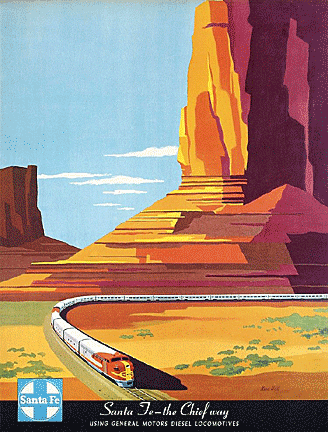 I
have been collecting travel posters for some time. Recently, I
purchased one from the Santa Fe Railroad and another from the
B&O R.R. These appear to be in an Art Deco style but I have no
idea who created them or exactly when they were in use. Can you
help me? I
have been collecting travel posters for some time. Recently, I
purchased one from the Santa Fe Railroad and another from the
B&O R.R. These appear to be in an Art Deco style but I have no
idea who created them or exactly when they were in use. Can you
help me?
Thanks,
Ben
____________________________________________________
ANSWER:
Railroad posters reached their peak during the Art Deco Movement from
1925 to 1940. Most were so well designed that they’ve become
art—collectible art.
Almost immediately after railroad workers drover the final spike into
the 1,912-mile First Transcontinental Railroad at Promontory Summit,
Utah, on May 10, 1869, marketers began producing posters and other
advertising materials designed to lure farmers and entrepreneurs living
east of the Mississippi River to the Wild West. This sort of marketing
effort was hardly unique to the United States.
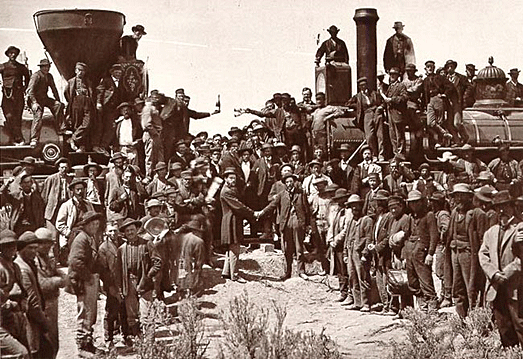
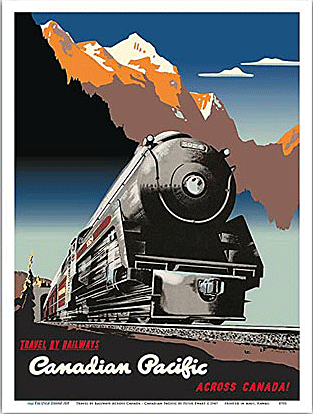 On
November 7, 1885, when Canadians celebrated the completion of their
nation’s even longer transcontinental railroad at Craigellachie, British
Columbia, luring settlers west via advertising was deemed an essential
part of nation-building. Indeed, executives of the Canadian Pacific
Railway relied so heavily on graphic design, by the 1930s they had made
room for a dedicated silkscreen studio within Montreal’s railway
station, where the company produced posters and other materials by the
thousands. On
November 7, 1885, when Canadians celebrated the completion of their
nation’s even longer transcontinental railroad at Craigellachie, British
Columbia, luring settlers west via advertising was deemed an essential
part of nation-building. Indeed, executives of the Canadian Pacific
Railway relied so heavily on graphic design, by the 1930s they had made
room for a dedicated silkscreen studio within Montreal’s railway
station, where the company produced posters and other materials by the
thousands.
Similarly, half a world away in New Zealand, that nation’s Railways
Department set up its own Railways Studios in 1915, defining the look of
outdoor advertising in the country for more than half a century. But
unlike in the United States and Canada, where the initial task was to
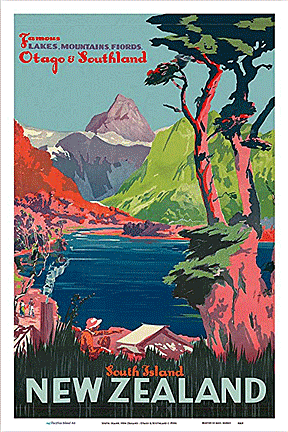 encourage
settlement, the goals for the posters that came out of Railway Studios
were always about getting New Zealanders to explore their multi-island
nation by rail. That last part was especially important because between
World War I and World War II, New Zealand had become one of the most
car-crazy countries in the world. But the artists hired by Railways
Studios did such a good job of encouraging the public to take their
weekend getaways by train that attendance at churches actually suffered. encourage
settlement, the goals for the posters that came out of Railway Studios
were always about getting New Zealanders to explore their multi-island
nation by rail. That last part was especially important because between
World War I and World War II, New Zealand had become one of the most
car-crazy countries in the world. But the artists hired by Railways
Studios did such a good job of encouraging the public to take their
weekend getaways by train that attendance at churches actually suffered.
Train travel allowed the middle and lower classes the ability to leave
their remote town, head into a city, or escape from it as needed.
Vacations became a notion that the general public could take; affordable
weekend escapes in lieu of expensive months-long excursions reserved
only for the rich. With this widening pool of people on-the-go, trains
also changed the way people perceived the passing of time. Small towns
between major cities became bustling centers that could be explored
between train transfers, and entire sub-industries such as modern hotels
and cafes began to spring up in formerly remote regions.
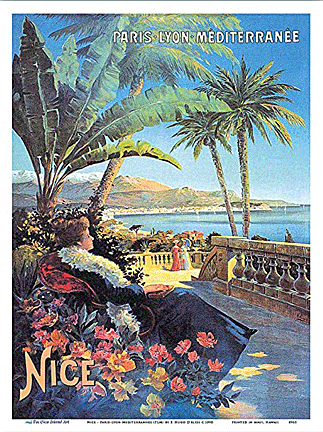 This
growth in travel via train was a trend that continued through the first
half of the 20th century. During the period of the eighty year boom in
train travel, countless posters appeared in railway stations. Often
bright and exciting, they offered the possibilities of new places to
explore. This
growth in travel via train was a trend that continued through the first
half of the 20th century. During the period of the eighty year boom in
train travel, countless posters appeared in railway stations. Often
bright and exciting, they offered the possibilities of new places to
explore.
The Compagnie des Chemins de Fer de Paris à Lyon et à la Méditerranée―known
simply as the PLM―was a French railway company founded during the
initial growth of train travel, around 1859. PLM commissioned now famous
poster artists such as Roger Broders. PLM would sponsor these artist’s
travels to the Côte d’Azur and the French Alps so that they could visit
the subjects of their work and depict them in the most accurate detail.
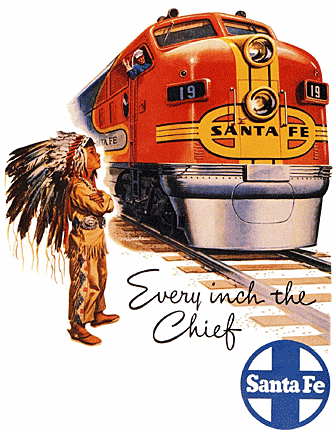 The
Santa Fe Railroad was one of the larger railroads in the United States
during the times of the “Wild West”. Chartered in 1859, the railroad
reached the Kansas-Colorado border in 1873 and Pueblo, Colorado, in
1876. To create a demand for its services, the railroad set up real
estate offices and sold farm land from the land grants that it was
awarded by Congress. Despite the name, its main line never served Santa
Fe, New Mexico, as the terrain was too difficult. The
Santa Fe Railroad was one of the larger railroads in the United States
during the times of the “Wild West”. Chartered in 1859, the railroad
reached the Kansas-Colorado border in 1873 and Pueblo, Colorado, in
1876. To create a demand for its services, the railroad set up real
estate offices and sold farm land from the land grants that it was
awarded by Congress. Despite the name, its main line never served Santa
Fe, New Mexico, as the terrain was too difficult.
The Pennsylvania Railroad, commonly referred to as the “Pennsy,” was
headquartered in Philadelphia, Pennsylvania. The PRR was the largest
railroad in the U.S. for the entire first half of the 20th century. Its
posters promoted cities throughout its vast network.
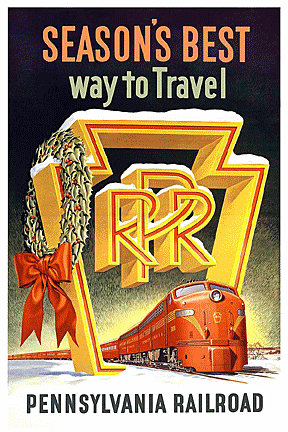 Once
summoning travelers from near and far, vintage railroad posters have
come to serve as delightful reminders of happy vacations, honeymoons,
and historic periods in time. Now seen as art and highly sought after by
collectors, there has been a particular resurgence in the interest in
railway travel posters., Once
summoning travelers from near and far, vintage railroad posters have
come to serve as delightful reminders of happy vacations, honeymoons,
and historic periods in time. Now seen as art and highly sought after by
collectors, there has been a particular resurgence in the interest in
railway travel posters.,
Railroad posters were a form of powerful advertising in the early 20th
century. With their brilliant colors and ability to radiate a sense of
adventure and exploration, they enticed people to book trips by train.
The railroads commissioned most of the posters themselves .They were
commissioned in a fairly standard format because the typical way of
displaying them was inside rail stations. There were pre-made train
posters that hung on the wall, and the local trainmaster would switch
out the poster as new ones came in. So the travel posters would be in
the same format and would wonderfully represent city and resort
destinations, as well as weekend getaways along the railroad’s route.
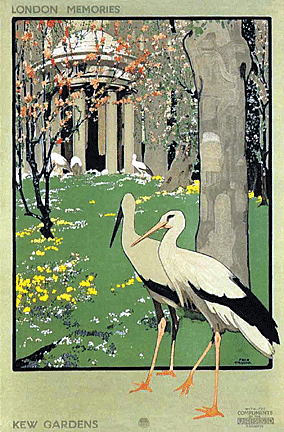 The
turn of the 20th century was a time of the early spread of the
distribution lines of the rail companies. They reached more destinations
and had to promote travel to these destinations. At the same time, they
had to convey to people how much quicker this was than anything
previously available. The
turn of the 20th century was a time of the early spread of the
distribution lines of the rail companies. They reached more destinations
and had to promote travel to these destinations. At the same time, they
had to convey to people how much quicker this was than anything
previously available.
A number of very famous artists worked on travel posters in the early
era, and many people collect for the artist. They’re also collectible
because of their beautiful graphics – they show charming scenes and
beautiful colors – and because of their destinations. They might
symbolize an important time in someone’s life, be it a honeymoon, or a
place they studied, or a place the family frequently visited.
Fortunately, railroads produced posters in a size—approximately 29 x 39
inches----that fits well in today’s homes and small apartments.
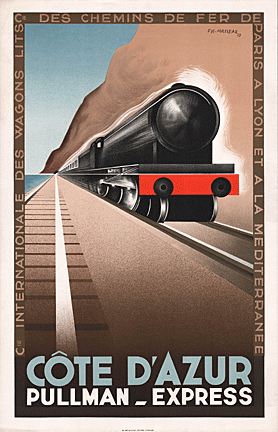 The
Art Deco Movement from 1925 to 1939 influenced the design of most
railroad posters of the time while those produced in the early 1900s
were more influenced by Art Nouveau. During the first half of the 20th
century, posters were powerful method of promotion. The
Art Deco Movement from 1925 to 1939 influenced the design of most
railroad posters of the time while those produced in the early 1900s
were more influenced by Art Nouveau. During the first half of the 20th
century, posters were powerful method of promotion.
Stylistically, railroad posters varied by region or country. The posters
produced by London’s Underground during the 1920s and ’30s used Art Deco
images and design to lure residents and tourists alike to flowers in Kew
Gardens, theaters in the West End, and the city’s famous zoo. During the
same period, the Art Deco style gave an air of mystery to Japanese
railway posters which enticed travelers to visit Japan’s numerous
natural parks, where waterfalls and hot springs awaited. And while
depictions of trains may have been absent in those posters, sales copy
with detailed descriptions of discounts were not. Even though these
posters were beautiful, they always had to earn their keep as sales
tools.
<
Back to Readers Ask Archives
Next Article > |
